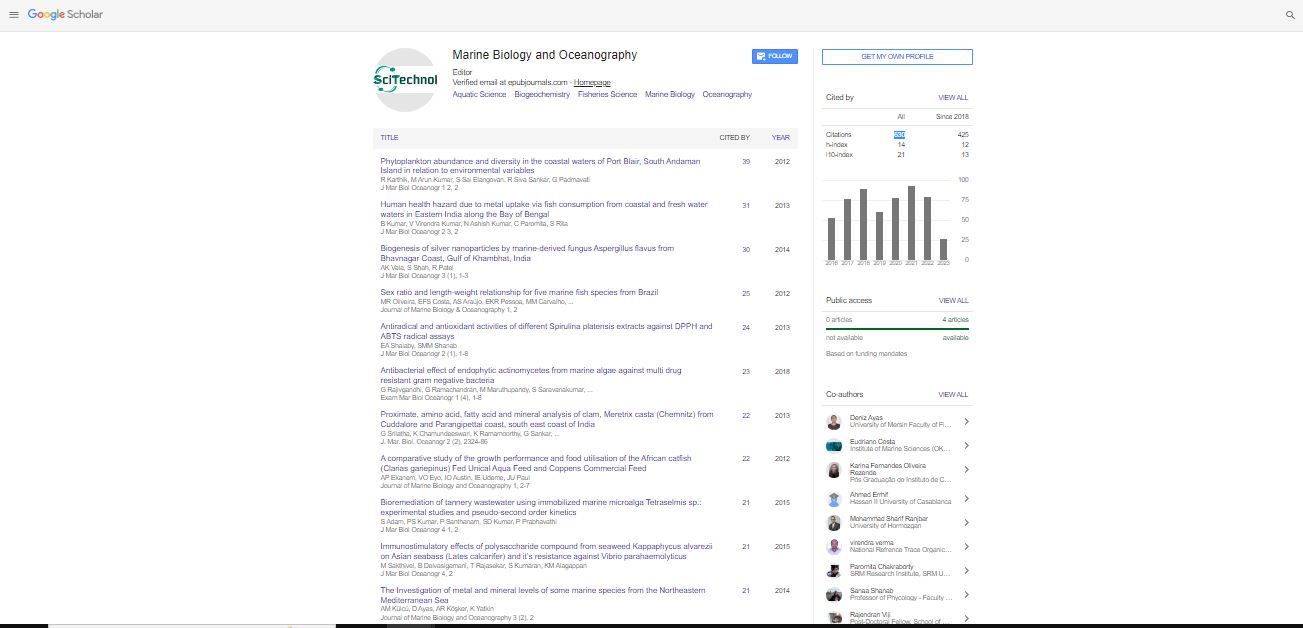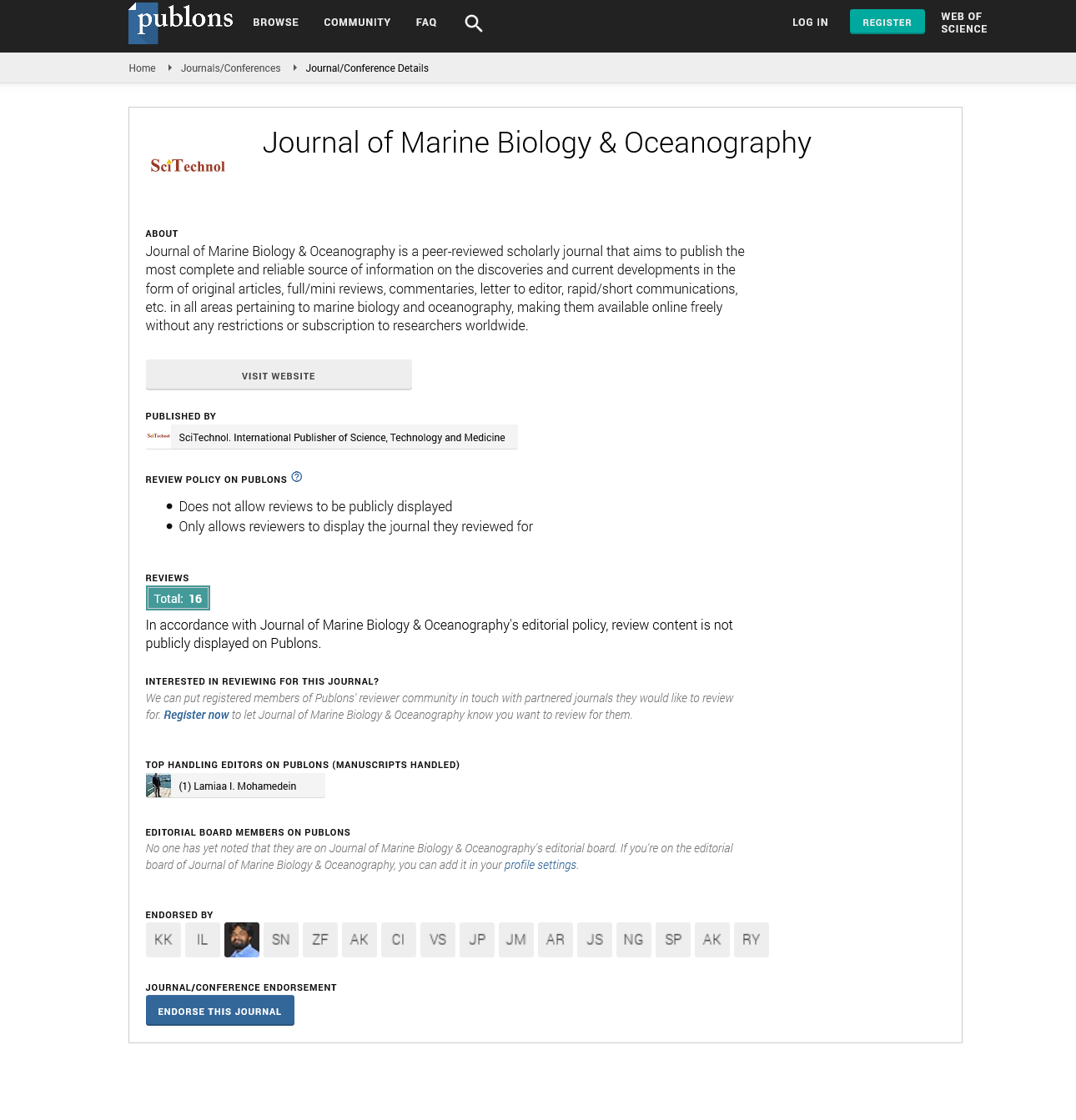Commentary, J Mar Biol Oceanogr Vol: 12 Issue: 3
Evaluating the Roles and Interactions of Diverse Marine Organisms
Hamid Paul*
1Department of Environmental Sciences, University of Siena, Siena, Italy
*Corresponding Author: Hamid Paul,
Department of Environmental Sciences,
University of Siena, Siena, Italy
E-mail: hamid_paul@us21.it
Received date: 22 May, 2023, Manuscript No. JMBO-23-105098;
Editor assigned date: 25 May, 2023, PreQC No. JMBO-23-105098 (PQ);
Reviewed date: 08 June, 2023, QC No. JMBO-23-105098;
Revised date: 15 June, 2023, Manuscript No. JMBO-23-105098 (R);
Published date: 22 June, 2023, DOI: 10.4172/2324-8661.1000273.
Citation: Paul H (2023) Evaluating the Roles and Interactions of Diverse Marine Organisms. J Mar Biol Oceanogr 12:3.
Description
The vast and mysterious ocean is teeming with life, harboring an incredible array of diverse marine organisms. From microscopic plankton to massive whales, each organism plays a unique role in shaping the complex web of life within marine ecosystems. At the foundation of marine ecosystems lie the primary producers, such as phytoplankton and algae. These microscopic organisms absorb the power of sunlight through photosynthesis, converting carbon dioxide into organic matter and producing oxygen as a byproduct. They form the basis of the marine food chain, providing sustenance for a multitude of organisms.
One of the primary consumers in the marine realm is zooplankton, which includes tiny organisms such as krill and copepods. They graze on phytoplankton and serve as a vital food source for a variety of marine organisms, including small fish and filter-feeding invertebrates. Zooplankton also plays a role in nutrient cycling, as they excrete waste products that contribute to the availability of essential nutrients for other organisms.
Moving up the trophic levels, small fish and invertebrates become important consumers within marine ecosystems. They occupy a range of niches, feeding on a variety of food sources, including zooplankton, detritus, and smaller organisms. These organisms serve as prey for larger predators, thereby transferring energy and nutrients through the food chain.
Predatory fish, such as sharks and large predatory fish species, exert top-down control within marine food webs. They regulate populations of smaller fish and invertebrates, preventing them from becoming overly abundant and disrupting ecosystem balance. Predatory fish also play an essential role in maintaining healthy ecosystems by selectively preying on weaker individuals, thus ensuring the survival of fitter and more genetically diverse populations.
Marine mammals, including whales, dolphins, seals, and sea lions, occupy various niches and contribute to the structure and functioning of marine ecosystems. They are often apex predators and have a cascading effect on the entire food web. For instance, whales play an important role in nutrient cycling through a process called the "whale pump." Their feeding activities in nutrient-rich areas bring nutrients from deeper waters to the surface, promoting the growth of phytoplankton and supporting a productive ecosystem.
Benthic organisms, which inhabit the seafloor, are integral components of marine ecosystems. Invertebrates such as crabs, lobsters, and sea stars serve as scavengers and decomposers, breaking down organic matter and recycling nutrients back into the ecosystem. They help maintain water quality by removing dead and decaying organisms and preventing the buildup of organic debris.
Coral reefs often referred to as the "Rainforests of the Sea," harbor an astonishing diversity of marine organisms and are renowned for their intricate interactions. Corals, together with symbiotic algae called zooxanthellae, form a mutually beneficial relationship known as symbiosis. The corals provide shelter and nutrients to the algae, while the algae, through photosynthesis, provide food and contribute to the vibrant colors of the coral reefs. This symbiotic relationship is the foundation for the incredible biodiversity and productivity of coral reef ecosystems.
Conclusion
The world beneath the waves is filled with diverse marine organisms, each playing an essential role in maintaining the balance and functioning of marine ecosystems. From the smallest plankton to the largest predators, the intricate interactions among these organisms shape the structure and dynamics of the marine world. By understanding and appreciating these roles and interactions, one can foster a deeper respect for the ocean and strive to protect and conserve its magnificent biodiversity for generations to come. However, marine ecosystems face numerous threats, including habitat destruction, pollution, overfishing and climate change. It is vital to recognize the significance of these interactions and work towards sustainable practices and conservation efforts to safeguard the diversity and integrity of marine organisms and their habitats.
 Spanish
Spanish  Chinese
Chinese  Russian
Russian  German
German  French
French  Japanese
Japanese  Portuguese
Portuguese  Hindi
Hindi 
